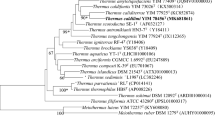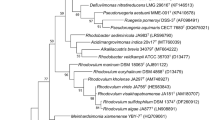Abstract
Two closely related thermophilic bacterial strains, designated YIM 71031T and YIM 71039, were isolated from a hot spring in Tengchong county, Yunnan province, south-western China. The novel isolates were observed to be Gram-negative, aerobic, rod-shaped and yellow-pigmented bacteria. The strains were found to be able to grow at 37–65 °C, pH 6.0–9.0 and with a NaCl tolerance up to 1.0 % (w/v). Phylogenetic analysis based on 16S rRNA gene sequences placed these two isolates in the genus Meiothermus. They were found to be closely related to Meiothermus timidus DSM 17022T (98.6 % similarity), and formed a cluster with this species. The predominant menaquinone was identified as MK-8 and the major fatty acids (>10 %) as anteiso-C15:0, iso-C15:0, anteiso-C17:0, iso-C16:0 and C16:0. The genomic DNA G+C contents of strains YIM 71031T and YIM 71039 were determined to be 64.0 and 65.4 mol%, respectively. DNA–DNA hybridizations showed low values between strains YIM 71031T and YIM 71039 and their closely related neighbour M. timidus DSM 17022T. Morphological phylogenetic and chemotaxonomic results suggest that strains YIM 71031T and YIM 71039 are representatives of a new species within the genus Meiothermus, for which the name Meiothermus roseus sp. nov. is proposed. The type strain is YIM 71031T (=KCTC 42495T =NBRC 110900T).

Similar content being viewed by others
References
Albuquerque L, Ferreira C, Tomaz D, Tiago I, Veríssimo A, da Costa MS, Nobre MF (2009) Meiothermus rufus sp. nov., a new slightly thermophilic red-pigmented species and emended description of the genus Meiothermus. Syst Appl Microbiol 32:306–313
Albuquerque L, Rainey FA, Nobre MF, da Costa MS (2010) Meiothermus granaticius sp. nov., a new slightly thermophilic red-pigmented species from the Azores. Syst Appl Microbiol 33:243–246
Altschul SF, Gish W, Miller W, Myers EW, Lipman DJ (1990) Basic local alignment search tool. J Mol Biol 215:403–410
Bjornsdottir SH, Petursdottir SK, Hreggvidsson GO, Skirnisdottir S, Hjorleifsdottir S, Arnfinnsson J, Kristjansson JK (2009) Thermus islandicus sp. nov., a mixotrophic sulfur-oxidizing bacterium isolated from the Torfajokull geothermal area. Int J Syst Evol Microbiol 59:2962–2966
Buck JD (1982) Nonstaining (KOH) method for determination of Gram reactions of marine bacteria. Appl Environ Microbiol 44:992–993
Chen MY, Lin GH, Lin YT, Tsay SS (2002) Meiothermus taiwanensis sp. nov., a novel filamentous, thermophilic species isolated in Taiwan. Int J Syst Evol Microbiol 52:1647–1654
Christensen H, Angen O, Mutters R, Olsen JE, Bisgaard M (2000) DNA-DNA hybridization determined in micro-wells using covalent attachment of DNA. Int J Syst Evol Microbiol 50:1095–1102
Chung AP, Rainey F, Nobre MF, Burghardt J, Da Costa MS (1997) Meiothermus cerbereus sp. nov., a new slightly thermophilic species with high levels of 3-hydroxy fatty acids. Int J Syst Bacteriol 47:1225–1230
Chung AP, Rainey FA, Valente M, Nobre MF, da Costa MS (2000) Thermus igniterrae sp. nov. and Thermus antranikianii sp. nov., two new species from Iceland. Int J Syst Evol Microbiol 50:209–217
Collins MD, Jones D (1980) Lipids in the classification and identification of coryneform bacteria containing peptidoglycans based on 2,4-diaminobutyric acid. J Appl Bacteriol 48:459–470
Collins MD, Pirouz T, Goodfellow M, Minnikin DE (1977) Distribution of menaquinones in actinomycetes and corynebacteria. J Gen Microbiol 100:221–230
da Costa MS, Rainey FA, Nobre MF (2006) The genus Thermus and relatives. In: Dworkin M, Falkow S, Rosenberg E, Schleifer KH, Stackebrandt E (eds) The prokaryotes, vol 7, 3rd edn. Springer, New York, pp 797–812
Ezaki T, Hashimoto Y, Yabuuchi E (1989) Fluorometric deoxyribonucleic acid-deoxyribonucleic acid hybridization in microdilution wells as an alternative to membrane filter hybridization in which radioisotopes are used to determine genetic relatedness among bacterial strains. Int J Syst Bacteriol 39:224–229
Felsenstein J (1981) Evolutionary trees from DNA sequences: a maximum likelihood approach. J Mol Evol 17:368–376
Felsenstein J (1985) Confidence limits on phylogenies: an approach using the bootstrap. Evolution 39:783–789
Fitch WM (1971) Toward defining the course of evolution: minimum change for a specific tree topology. Syst Zool 20:406–416
Gonzalez C, Gutierrez C, Ramirez C (1978) Halobacterium vallismortis sp. nov. an amylolytic and carbohydrate-metabolizing, extremely halophilic bacterium. Can J Microbiol 24:710–715
Groth I, Rodríguez C, Schütze B, Schmitz P, Leistner E, Goodfellow M (2004) Five novel Kitasatospora species from soil: Kitasatospora arboriphila sp. nov., K. gansuensis sp. nov., K. nipponensis sp. nov., K. paranensis sp. nov. and K. terrestris sp. nov. Int J Syst Evol Microbiol 54:2121–2129
Guindon S, Gascuel O (2003) A simple, fast, and accurate algorithm to estimate large phylogenies by maximum likelihood. Syst Biol 52(5):696–704
Hu H, Lim B, Naohiro G, Koich FJ (2001) Analytical precision and repeatability of respiratory quinones for quantitative study of microbial community structure in environmental samples. J Microbiol Methods 47:17–24
Kim OS, Cho YJ, Lee K, Yoon SH, Kim M, Na H, Park SC, Jeon YS, Lee JH, Yi H, Won S, Chun J (2012) Introducing EzTaxon-e: a prokaryotic 16S rRNA gene sequence database with phylotypes that represent uncultured species. Int J Syst Evol Microbiol 62:716–721
Kimura M (1980) A simple method for estimating evolutionary rates of base substitutions through comparative studies of nucleotide sequences. J Mol Evol 16:111–120
Kimura M (1983) The neutral theory of molecular evolution. Cambridge University Press, Cambridge
Kovacs N (1956) Identification of Pseudomonas pyocyanea by the oxidase reaction. Nature 178:703
Leifson E (1960) Atlas of bacterial flagellation. Academic Press, London
Li WJ, Xu P, Schumann P, Zhang YQ, Pukall R, Xu LH, Stackebrandt E, Jiang CL (2007) Georgenia ruanii sp. nov., a novel actinobacterium isolated from forest soil in Yunnan (China) and emended description of the genus Georgenia. Int J Syst Evol Microbiol 57:1424–1428
Loginova L, Egorova L, Golovacheva R, Seregina L (1984) Thermus ruber sp. nov., nom. rev. Int J Syst Bacteriol 34:498–499
MacFaddin JF (1980) Biochemical tests for identification bacteria, 2nd edn. Williams & Wilkins, Baltimore
Mesbah M, Premachandran U, Whitman WB (1989) Precise measurement of the G+C content of deoxyribonucleic acid by high-performance liquid chromatography. Int J Syst Bacteriol 39:159–167
Ming H, Yin YR, Li S, Nie GX, Yu TT, Zhou EM, Liu L, Dong L, Li WJ (2014) Thermus caliditerrae sp. nov., a novel thermophilic species isolated from a geothermal area. Int J Syst Evol Microbiol 64:650–656
Minnikin DE, Collins MD, Goodfellow M (1979) Fatty acid and polar lipid composition in the classification of Cellulomonas, Oerskovia and related taxa. J Appl Bacteriol 47:87–95
Minnikin DE, O’Donnell AG, Goodfellow M, Alderson G, Athalye M, Schaal A, Parlett JH (1984) An integrated procedure for the extraction of bacterial isoprenoid quinones and polar lipids. J Microbiol Methods 2:233–241
Mori K, Iino T, J-i Ishibashi, Kimura H, Hamada M, K-i Suzuki (2012) Meiothermus hypogaeus sp. nov., a moderately thermophilic bacterium isolated from a hot spring. Int J Syst Evol Microbiol 62:112–117
Nobre MF, Carreto L, Wait R, Tenreiro S, Fernandes O, Sharp RJ, da Costa MS (1996a) Fatty acid composition of the species of the genera Thermus and Meiothermus. Syst Appl Microbiol 19:303–311
Nobre MF, Trüper HG, da Costa MS (1996b) Transfer of Thermus ruber (Loginova et al. 1984), Thermus silvanus (Tenreiro et al. 1995), and Thermus chliarophilus (Tenreiro et al. 1995) to Meiothermus gen. nov. as Meiothermus ruber comb, nov., Meiothermus silvanus comb. nov., and Meiothermus chliarophilus comb. nov., respectively, and emendation of the genus Thermus. Int J Syst Evol Microbiol 49:1951
Pires AL, Albuquerque L, Tiago I, Nobre MF, Empadinhas N, Veríssimo A, da Costa MS (2005) Meiothermus timidus sp. nov., a new slightly thermophilic yellow-pigmented species. FEMS Microbiol Lett 245:39–45
Saitou N, Nei M (1987) The neighbor-joining method: a new method for reconstructing phylogenetic tree. Mol Biol Evol 4:406–425
Sasser M (1990) Identification of bacteria by gas chromatography of cellular fatty acids. USFCC Newsl 20:16
Smibert RM, Krieg NR (1994) Phenotypic characterization. In: Gerhardt P, Murray RGE, Wood WA, Krieg NR (eds) Methods for general and molecular bacteriology. American Society for Microbiology, Washington DC, pp 607–654
Tamaoka J, Katayama-Fujimura Y, Kuraishi H (1983) Analysis of bacterial menaquinone mixtures by high performance liquid chromatography. J Appl Bacteriol 54:31–36
Tamura K, Stecher G, Peterson D, Filipski A, Kumar S (2013) MEGA6: molecular evolutionary genetics analysis version 6.0. Mol Biol Evol 30(12):2725–2729
Tenreiro S, Nobre MF, Da Costa MS (1995) Thermus silvanus sp. nov. and Thermus chliarophilus sp. nov., two new species related to Thermus ruber but with lower growth temperatures. Int J Syst Bacteriol 45:633–639
Thompson JD, Gibson TJ, Plewniak F, Jeanmougin F, Higgins DG (1997) The Clustal_X windows interface: flexible strategies for multiple sequence alignment aided by quality analysis tools. Nucleic Acids Res 25:4876–4882
Wayne LG, Brenner DJ, Colwell RR, Grimont PAD, Kandler O, Krichevsky MI, Moore LH, Moore WEC, Murray RGE, Stackebrandt E, Starr MP, Trüper HG (1987) International committee on systematic bacteriology. Report of the ad hoc committee on reconciliation of approaches to bacterial systematics. Int J Syst Bacteriol 37:463–464
Williams RAD, da Costa MS (1992) The genus Thermus and related microorganisms. In: Balows A, Trüper HG, Dworkin M, Harder W, Schleifer KH (eds) The prokaryotes, 2nd edn. Springer, New York, pp 3745–3753
Yu TT, Yin YR, Zhang YG, Yao JC, Klenk HP, Wang HF, Ming H, Zhou EM, Li WJ (2014) Meiothermus terrae sp. nov., isolated from a geothermally heated soil sample. Int J Syst Evol Microbiol 64:794–798
Zhang XQ, Zhang WJ, Wei BP, Xu XW, Zhu XF, Wu M (2010) Meiothermus cateniformans sp. nov., a slightly thermophilic species from north-eastern China. Int J Syst Evol Microbiol 60:840–844
Acknowledgments
The authors are grateful to Prof. Hans-Peter Klenk (DSMZ, Germany) for his kind providing of the reference type strain. This research was supported by the Key Project of International Cooperation of Ministry of Science & Technology (MOST) (No. 2013DFA31980), Natural Science Foundation of China (Nos. 31372545 and 31470139), Program for Innovative Research Team (in Science and Technology) in University of Henan Province (14IRTSTHN013), Plan for Scientific Innovation Talent of Henan Province (154100510010), Scientific Research Fund of Xinxiang Medical University (2013QN126), Research Project of Education Department of Henan Province of China (2011A180025). W.-J. Li was also supported by the Guangdong Province Higher Vocational Colleges & Schools Pearl River Scholar Funded Scheme (2014).
Author information
Authors and Affiliations
Corresponding authors
Additional information
Hong Ming and Yan-Yan Duan contributed equally to this study.
Electronic supplementary material
Below is the link to the electronic supplementary material.
Rights and permissions
About this article
Cite this article
Ming, H., Duan, YY., Guo, QQ. et al. Meiothermus roseus sp. nov., a thermophilic bacterium isolated from a geothermal area. Antonie van Leeuwenhoek 108, 897–905 (2015). https://doi.org/10.1007/s10482-015-0544-x
Received:
Accepted:
Published:
Issue Date:
DOI: https://doi.org/10.1007/s10482-015-0544-x




